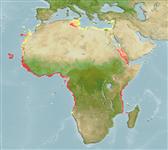Elasmobranchii (sharks and rays) >
Myliobatiformes (Stingrays) >
Dasyatidae (Stingrays)
Etymology: Taeniura: Latin, taenia = stripe + Greek, oura = tail (Ref. 45335).
Environment / Climate / Range
Ecology
Marine; demersal; depth range 10 - 300 m (Ref. 6808). Subtropical, preferred ?; 38°N - 17°S, 26°W - 44°E
Eastern Atlantic: Canary Islands (Ref. 6808) and Mauritania to Angola, including Cape Verde. Also in the Mediterranean, from Tunisia to Egypt.
Size / Weight / Age
Maturity: Lm ? range ? - ? cm
Max length : 250 cm TL male/unsexed; (Ref. 4438); max. published weight: 84.0 kg (Ref. 40637)
A neritic, coastal species (Ref. 27000). Generally found on sand and rock-sand bottoms (Ref. 6808). Partially covered with sand or mud. Feeds on bottom-living fishes and crustaceans. Ovoviviparous (Ref. 50449).
Life cycle and mating behavior
Maturity | Reproduction | Spawning | Eggs | Fecundity | Larvae
Exhibit ovoviparity (aplacental viviparity), with embryos feeding initially on yolk, then receiving additional nourishment from the mother by indirect absorption of uterine fluid enriched with mucus, fat or protein through specialised structures (Ref. 50449). Distinct pairing with embrace (Ref. 205).
Capapé, C. and M. Desoutter, 1990. Dasyatidae. p. 59-63. In J.C. Quero, J.C. Hureau, C. Karrer, A. Post and L. Saldanha (eds.) Check-list of the fishes of the eastern tropical Atlantic (CLOFETA). JNICT, Lisbon; SEI, Paris; and UNESCO, Paris. Vol. 1. (Ref. 4438)
IUCN Red List Status (Ref. 115185)
CITES (Ref. 94142)
Not Evaluated
Threat to humans
Harmless
Human uses
Fisheries: commercial
More information
ReferencesAquacultureAquaculture profileStrainsGeneticsAllele frequenciesHeritabilityDiseasesProcessingMass conversion
Tools
Special reports
Download XML
Internet sources
